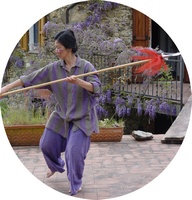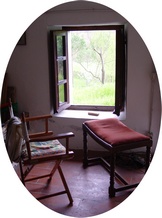
excerpt
LaoJia 2 ~ realignments
Today is an indoors day. Some of the daffodils were rescued before more rain; the valley has disappeared.
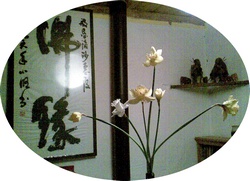
Chapter 5 covered the first six minutes of a one-hour lesson. If we continue at this rate, I risk losing my publisher, so let us now skip ahead and look at some illustrative sequences from later on.
I think it was in the Cloud Hands sequence that I was won over to LaoJia and Chen Style. In the old days, Cloud Hands was never cloud-like enough for me. For years during my Yang Style days, I had tried maybe five variations of Cloud Hands, all of them having a common factor of two-dimensionality. Some teachers had taught it high, some lower, but it had always felt to me that the hands were drawing shapes in the air, not coming out of the body organically. It had been somewhat of a mental exercise, carefully turning and bringing the hands across the chest, the gaze locked into the rectangular shape which the arms were describing.
Now here, finally, was a way which made sense instinctively. The two arms express a complex of spirals spun out from within. They move along pathways that are inevitable; the hands are the visible ends of an invisible power. Learning these new movements in class, during the ten-day seminar that preceded this lesson, I had thought to myself, “Wow, this is really interesting stuff!”— even though I had barely tasted chansijin as yet, and thus could not give reasons for my feelings. Indeed, in that seminar I had merely learned the movements, without any contact with jin. Being guided was a hundred times better. I got a virtual ride on Master Chen’s freeway. I fairly breezed along, enjoying lightness and oneness.
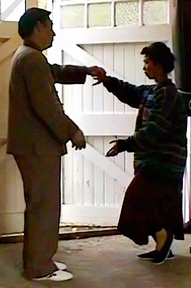 |
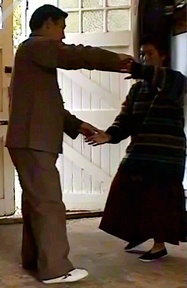 |
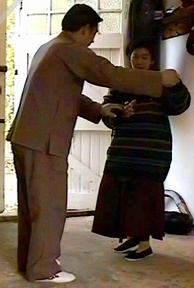 |
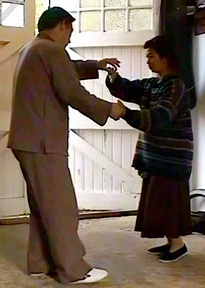 |
Chen XiaoWang’s touch is jin. He spins it out of his core; watching him clean a swimming pool is a lesson in jin economy. On that bright November day in 1995, the Cloud Hands sparkle. There is no feeling of repeating the same moves, as it had felt when done in the old way. The arm emerges fresh from below each time, and travels its circuit fully, without being boxed into shapes. As free as it feels, it is ruled by an inner rhythm, manifested in the timing of the steps. The steps run the lower thread, while the arms loop in and out of the base line, in perpetual ever-changing changeless.
 |
Gone, finally, was the methodical procession of two arms travelling in convoy across the chest. Ordering the arms to move in this fashion had been part of the ‘nose-over-navel’ approach. Pytt Geddes had loosened it up somewhat; she had emphasized the turning at the waist, allowing the upper body to swivel upon the hips fixed to face front. Now in Chen Style, I was discovering the waist to be a wide beltway, a concourse connecting chest and pelvis, a stretchy spirally core.
It was that, and at the same time it was a precise pivotal point low down in the back. But before I could appreciate subtleties, I needed to get used to another way of stepping sideways. Previously, I had been taught to step sideways in such a way that the inner front part of the foot gently caresses the ground first, and then the main bodyweight rolls onto the foot proper. We had been regaled with rumours that in Chen Taiji, the sideways stepping is such that the heel arrives at the ground first. This was viewed with great suspicion — it had seemed so crude and peasant-like. In reality, the heel-first sideways stepping is a matter of delicate strength and control. The leg extends from the centre, reaching out like a curvy tentacle, the foot sucking up the ground. Once it begins to develop, the inner twining that happens in the legs leads one to step heel first, and stepping in this way keeps the twining going.
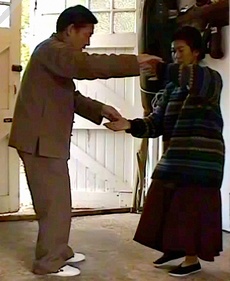 |
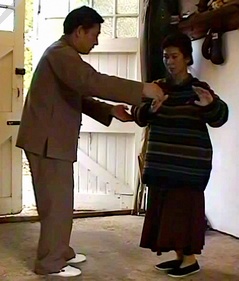 |
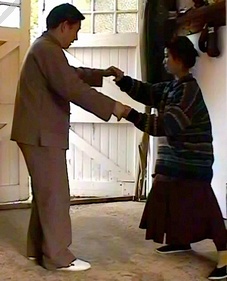 |
Cloud Hands is a pure expression of the twining that is fundamental in Chen Style. As we shall see in chapter 8, its logic has been extracted to create exercise A of single hand Chansigong. In Cloud Hands the arms twine out of phase, qi flowing in opposite directions on either side of the body, from dantian through mingmen and up the back, out to the fingers; from there coiling back along the arm to the waist and to dantian.
With Master Chen arresting my weight shifts as he guides me, I begin to appreciate a little the logic of the timing. Before the weight starts to shift, the upper arm has to sink as it spirals out sideways, an action linked through the core to the lower arm’s rising. It feels like a complex change inside. The moments in time when one hand is rising while the other descends become slowed down. In this stretchy interval I feel little swivellings at the sides of the waist; only after these seem to move into place am I allowed to begin the weight shift. Then the transfer of weight feels deliberate and powerful. I am quite awed by the sensations of unknown mechanisms at work within.

Finally (left, 39m33)… try it by yourself! Not knowing yet any twining silk exercises, I have to trust beginner’s mind. The arms feel wondrous, my posture just enough together to give support to the nebulous weaving motion.
Chen Style TaijiQuan is dramatic. Through being trained steadily in ZhanZhuang and Chansigong one comes to the practice of forms, such as LaoJia or XinJia, with an increasingly clear idea of the inner structure that makes the drama real and sustainable.
It is one thing to have a powerful experience after posture correction, and quite another to be able to move from A to B. Bombarded by qi blasts when we are adjusted in static stances, it is easy to forget that TaijiQuan is a technique of movement. It is a way of moving without losing centre. The adjustments that one receives from the teacher are for guiding one in learning how to move. A snapshot of the skilful taiji practicant taken at any moment should show a balanced and uncompromised frame. The initial challenge is to maintain the connections established in position A as one travels to position B, but the further aim is to transform position into continuity and thus to become free of position.
Chen XiaoWang’s way of moving is both classical and free.
The curious thing is that freedom may be found through
hundreds of ‘reps’, rounds of practice of the same form,
over years, with a calm heart and a detached mind. 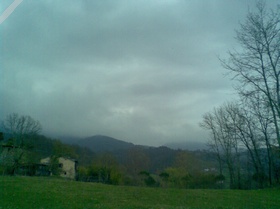 One must
practise in humility for a very long time. The loneliness
and solitude of solo practice give one resilience; facing
one’s difficulties makes one humble. It can be called a body
training, but without the heart’s perseverance and the
mind’s guiding light, it will not become art.
One must
practise in humility for a very long time. The loneliness
and solitude of solo practice give one resilience; facing
one’s difficulties makes one humble. It can be called a body
training, but without the heart’s perseverance and the
mind’s guiding light, it will not become art.
A neighbour calls from the other side of the ridge, and I go over to visit her. Their valley feels close but different, like a dissimilar twin. I walk back and see our settlement from the west, nestling gently into the side of a hill, clouds lowering in the east.
|
next |
